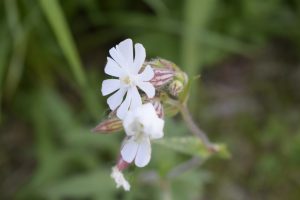White Campion

Silene latifolia first appears in June into July. Europe is the species origin, but white campion is not a “take over everything” type of non-native. Let’s just say these flowers appear in cottage gardens and along rural gravel roads and other disturbed areas in polite profusion, and can definitely become weedy in the landscape. Their brown, petal-laced cups of ripened fruit at the end of the season adds charm to dried flower bouquets.
Campion is an interesting flower in that it is dioecious, in other words separate individual plants are either male or female. The plant world is fascinating, and the more one delves into it, the more complexity there is to find. Intrigue, sexual tension, political maneuvering, invasive species marauding fields while natives attempt to endure on their lands to hold on to their own place. The two campion sexes present their own sort of drama in the form of slight variations in their flowers, each quite attractive in their own way and certainly to each other.

The female has long, slender white tubes (like narrow tongues) extruding from her center and a big, green bulbous behind. In botanist lingo she has five styles coming from her floral tube (center) and a bloated, green calyx. The male flower, in contrast, has ten short, pale yellow stamens (in polite terms) extruding from his floral tube, and a calyx that is more slender with green and more often deep burgundy coloration.
Flowers close up by noon, or later on cloudy days, only to open again the next morning.
